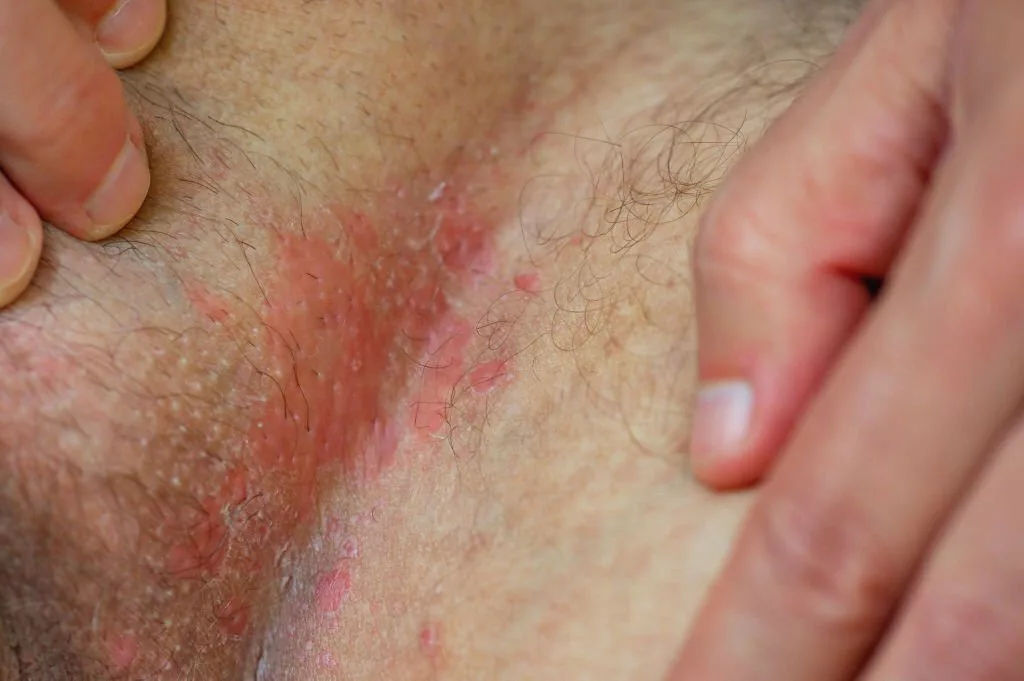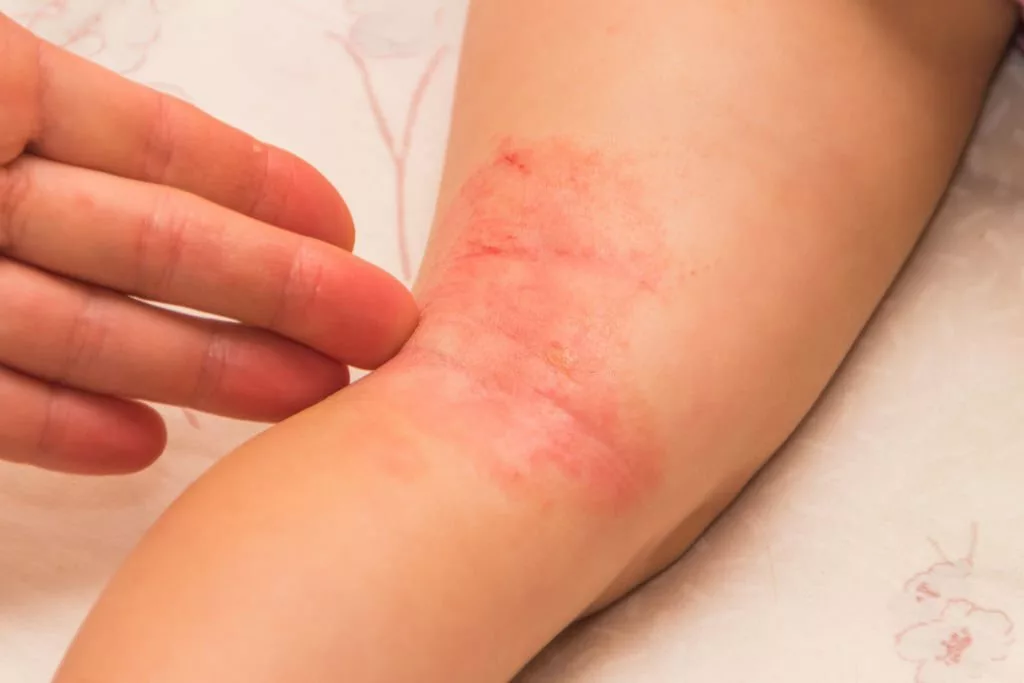Being the largest tissue of the body, the skin provides shelter to multiple microorganisms, including bacteria, fungi, and viruses. Most microorganisms are not harmful to the body and stay there. However, the presence of some microbes sparks the danger of skin infection, ranging from mild itching to severe infections. One such harmful microorganism is candida fungi. Candida fungi is a yeast that is present on the exposed surface of the human body, like hair, nails, and skin. When these fungi overgrow in the moist, warm folds of the skin, they can lead to Cutaneous Candidiasis.
What is Cutaneous Candidiasis?
Cutaneous Candidiasis is a common type of skin infection caused by fungi named candida. It mainly affects moist and creasy skin areas. In this disease, a red-to-brown rash appears on the skin.1R, A. N., & Rafiq, N. B. (2023). Candidiasis. In StatPearls. StatPearls Publishing. These itchy red rashes also disturb the aesthetic and health of the surrounding tissue.
Sometimes, the itching and infection become so severe that the patient develops sore, injured, and cracked skin. Some bacterial and systemic illnesses also cause a red rash on the skin. In this case, proper skin testing will reveal the causative agent and help the clinician start pharmacological intervention.
Congenital Cutaneous Candidiasis
Congenital cutaneous candidiasis is a rare candida infection that becomes apparent at birth or within the first week of life. This condition presents a spectrum of symptoms, ranging from a simple rash to severe cases that may result in organ failure and even death if immediate treatment is not administered. The primary cause of this condition is the transmission of candida fungus to the infant, either during fetal development inside the mother’s womb or during passage through the birth canal. This condition requires prompt treatment to save the infant’s life.2Kaufman, D. A., Coggins, S. A., Zanelli, S. A., & Weitkamp, J. H. (2017). Congenital Cutaneous Candidiasis: Prompt Systemic Treatment Is Associated With Improved Outcomes in Neonates. Clinical infectious diseases: an official publication of the Infectious Diseases Society of America, 64(10), 1387–1395. https://doi.org/10.1093/cid/cix119
What Are The Symptoms of Cutaneous Candidiasis?
The clinical manifestations of cutaneous candidiasis are:
- The red-colored rash most likely appeared on the skin folds and creases.
- Itching and soreness in the rash area.
- Severe itching causes skin cracks.3McKay M. (1988). Cutaneous manifestations of candidiasis. American journal of obstetrics and gynecology, 158(4), 991–993. https://doi.org/10.1016/0002-9378(88)90110-x
- Sometimes, a blister appears in the affected area. A blister is a fluid-filled elevation on the skin. They are painful to touch.
Mostly above symptoms appears in area that are friction-prone, moist, and warm, like armpits, groin area between the legs, between toes and fingers, and along the abdominal fold. Blisters mostly appear on the under the breast area and fingers. Between the legs, it mostly appears as a diaper rash.
Causes and Risk Factors For Cutaneous Candidiasis
Normal flora of the body means the microorganisms that are present on the skin and mucous membranes and are harmless to the body. Candida is a yeast that normally exists on the skin, mouth, digestive tract, and vagina without causing harm. However, sometimes, the persistent dampness, moisture on the skin, warm surface area, and compromised body defense system allow this harmless organism to grow uncontrolled, penetrate the skin, and cause infection. Commonly affected areas include the lining of the mouth, groin, armpits, and spaces between fingers and toes.4Palese, E., Nudo, M., Zino, G., Devirgiliis, V., Carbotti, M., Cinelli, E., Rodio, D. M., Bressan, A., Prezioso, C., Ambrosi, C., Scribano, D., Pietropaolo, V., Fioriti, D., & Panasiti, V. (2018). Cutaneous candidiasis caused by Candida albicans in a young non-immunosuppressed patient: an unusual presentation. International journal of immunopathology and pharmacology, 32, 2058738418781368. https://doi.org/10.1177/2058738418781368

Cutaneous candidiasis can be caused by various factors that promote the overgrowth of Candida yeast on the skin. These factors are:
- Poor hygiene: Compromised hygiene conditions favor the growth of fungus, especially in areas that are not self-cleansing, like toes and fingers. The presence of fungus in such areas promotes Cutaneous candidiasis.
- Moisture and warmth: The presence of moisture and warm temperature cause friction on the skin when it rubs with another skin part. This condition provides the bedrock for fungal growth.
- Improper diaper use: Using the same diaper for a long time causes it to become moist and unhygienic. This wet diaper allows fungal growth, which ultimately causes diaper rash on the skin.
- Antibiotic therapy: Taking antibiotics for a long time can disturb the normal flora of the skin and cause skin infection.
- Long-term steroid therapy: It weakens the defense system and allows fungal and bacterial agents to grow and multiply unconditionally. This uncontrolled growth results in candidiasis.
- Skin disorders: Existing skin conditions like psoriasis and intertrigo, which affect the skin creases, also provide favorable conditions for candida growth and cause an infection.
- Compromised immunity: Multiple diseases like chronic kidney failure, chronic heart disease, tumor production, diabetes, long-term chemotherapy, AIDS, and other viral infections can weaken the defense system of the body, which allows harmful organisms to multiply and cause infection.5Jagtap, S. A., Saple, P. P., & Dhaliat, S. B. (2011). Congenital cutaneous candidiasis: a rare and unpredictable disease. Indian journal of dermatology, 56(1), 92–93. https://doi.org/10.4103/0019-5154.77564

Diagnosis for Cutaneous Candidiasis
Most skin infections appear as red rash, making it difficult to differentiate the kind of infection and start treatment. The doctor may take the following steps to diagnose cutaneous candidiasis.
- History: Take a thorough medical history to identify potential risk factors.
- Examination: Conduct a complete physical examination to know the affected area and pattern of rash.
- Skin testing: Scrape the affected area and perform a potassium hydroxide wet mount test to determine the presence of yeast-like fungi in the culture. Culturing the specimen can aid the healthcare provider in confirming the diagnosis of candidiasis.
Treatment Intervention for Cutaneous Candidiasis
The treatment approach for cutaneous candidiasis focuses on two primary steps. Firstly, a pharmacological intervention involves prescribing anti-fungal medication tailored to the patient’s health status and the severity of the disease.6Taudorf, E. H., Jemec, G. B. E., Hay, R. J., & Saunte, D. M. L. (2019). Cutaneous candidiasis – an evidence-based review of topical and systemic treatments to inform clinical practice. Journal of the European Academy of Dermatology and Venereology: JEADV, 33(10), 1863–1873. https://doi.org/10.1111/jdv.15782 Second is the nonpharmacological intervention, which aims at lifestyle changes and dietary habits to reduce the incidence of risk factors related to cutaneous candidiasis in the body. Patients are advised to follow both steps to avoid the risk of candida infection.
Pharmacological Treatment
In the case of a simple rash or mild infection, the doctor may prescribe a topical antifungal cream or ointment containing clotrimazole or miconazole to apply to the skin. To prevent resistance, ensure that you apply the ointment correctly and follow the dosage instructions provided by the dermatologist.
In case of severe cases or blister presence, the doctor may opt for an antifungal cream with potent antifungal agents like nystatin or ketoconazole.7Cullin S. I. (1977). Cutaneous candidiasis: treatment with miconazole nitrate. Cutis, 19(1), 126–129.
If the infection proves resistant, the patient can undergo systemic antifungal therapy. It is essential to adhere strictly to the prescribed dosage provided by the clinician. Failing to complete the antifungal course can lead to the development of drug resistance in the body.

Non- Pharmacological Treatment
Besides taking antifungal medication, a self-care routine will help the patients combat this common skin infection. The self-care routine should focus on the following steps:
- Maintain body hygiene
- Change diapers frequently
- Wear loose clothing
- Avoid prolonged use of the same socks and undergarments
- Reduce sugar intake
- Maintain a healthy lifestyle and weight
Cutaneous Candidiasis Vs. Intertrigo
How Does Cutaneous Candidiasis Differ From Psoriasis?
Psoriasis and cutaneous candidiasis are distinct conditions that doctors can clinically differentiate through their appearance, location, and diagnostic tests. Psoriasis presents as thick, scaly patches on the elbows, knees, scalp, and lower back, often with family history and an autoimmune basis. Cutaneous candidiasis manifests as red, itchy rashes with satellite lesions in moist areas like the groin and armpits. Diagnosis of candidiasis is confirmed by identifying Candida yeast through skin scrapings and cultures, whereas psoriasis is diagnosed based on clinical appearance and, if needed, skin biopsy. However, there is an increased risk of developing yeast skin infections in patients with psoriasis.9Medical News Today. (2018). What to know about hydrocephalus. Retrieved June 18, 2024, from https://www.medicalnewstoday.com/articles/323561
Wrap-up
Refrences
- 1R, A. N., & Rafiq, N. B. (2023). Candidiasis. In StatPearls. StatPearls Publishing.
- 2Kaufman, D. A., Coggins, S. A., Zanelli, S. A., & Weitkamp, J. H. (2017). Congenital Cutaneous Candidiasis: Prompt Systemic Treatment Is Associated With Improved Outcomes in Neonates. Clinical infectious diseases: an official publication of the Infectious Diseases Society of America, 64(10), 1387–1395. https://doi.org/10.1093/cid/cix119
- 3McKay M. (1988). Cutaneous manifestations of candidiasis. American journal of obstetrics and gynecology, 158(4), 991–993. https://doi.org/10.1016/0002-9378(88)90110-x
- 4Palese, E., Nudo, M., Zino, G., Devirgiliis, V., Carbotti, M., Cinelli, E., Rodio, D. M., Bressan, A., Prezioso, C., Ambrosi, C., Scribano, D., Pietropaolo, V., Fioriti, D., & Panasiti, V. (2018). Cutaneous candidiasis caused by Candida albicans in a young non-immunosuppressed patient: an unusual presentation. International journal of immunopathology and pharmacology, 32, 2058738418781368. https://doi.org/10.1177/2058738418781368
- 5Jagtap, S. A., Saple, P. P., & Dhaliat, S. B. (2011). Congenital cutaneous candidiasis: a rare and unpredictable disease. Indian journal of dermatology, 56(1), 92–93. https://doi.org/10.4103/0019-5154.77564
- 6Taudorf, E. H., Jemec, G. B. E., Hay, R. J., & Saunte, D. M. L. (2019). Cutaneous candidiasis – an evidence-based review of topical and systemic treatments to inform clinical practice. Journal of the European Academy of Dermatology and Venereology: JEADV, 33(10), 1863–1873. https://doi.org/10.1111/jdv.15782
- 7Cullin S. I. (1977). Cutaneous candidiasis: treatment with miconazole nitrate. Cutis, 19(1), 126–129.
- 8Nobles T, Miller RA. Intertrigo. [Updated 2022 Sep 19]. In: StatPearls [Internet]. Treasure Island (FL): StatPearls Publishing; 2024 Jan-. Available from: https://www.ncbi.nlm.nih.gov/books/NBK531489/
- 9Medical News Today. (2018). What to know about hydrocephalus. Retrieved June 18, 2024, from https://www.medicalnewstoday.com/articles/323561

